The September Exodus: Fall Travel 2025
 |
| Fireweed blossoms tell us the end of summer is near. |
 |
| Salmonberries turn ruby red as they ripen. |
East Coast girl marries West Coast boy and shares their life adventures—Maine to Alaska, between and beyond. Travel, food, and family.
 |
| Fireweed blossoms tell us the end of summer is near. |
 |
| Salmonberries turn ruby red as they ripen. |
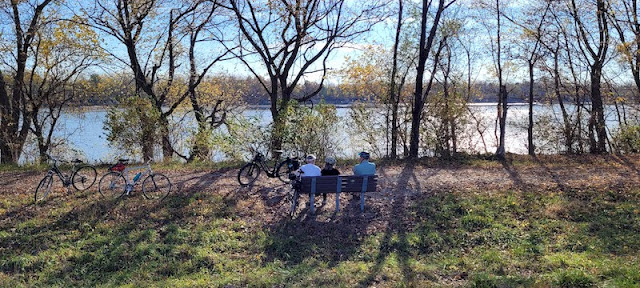 |
The Katy Trail provided plenty of places to stop, rest, and visit with friends. |
We survived the thick St. Louis traffic on I-70 to I-170 to I-270 and crossed the Missouri River to St. Charles, where Sundermeier RV Park was just down the road from the exit.
In just over three hours, we traveled through four states and crossed three of the largest rivers in the United States.
 |
We left the hilly landscape of West Virginia and Kentucky for the flat valley along the Missouri River. |
The best part of Sundermeier RV Park was access to the Katy Trail just out the back gate and the St. Charles Historic District, also known as Frenchtown, an easy 10-minute bike ride away.
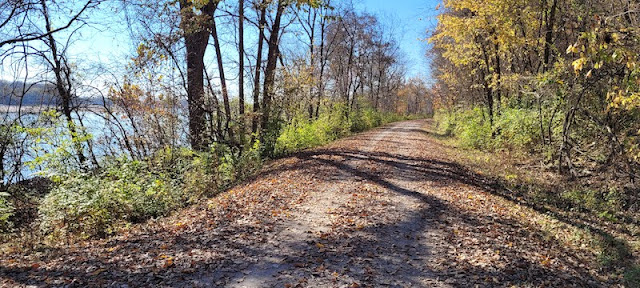 |
The Katy Trail is the former Missouri-Kansas-Texas railway. |
A mix of RV travelers and full-time residents filled most of the park. Our neighbor, Nate, was on his first RV trip, a real greenhorn. He was on his way to Texas. His remote job allowed him to travel. He shared a few tips and apps with us, and I told him about our travel blog, which includes an article about our trip through Texas in pre-COVID 2020. If you’re reading this, Hello, Nate! We hope you’re still enjoying your time on the road!
 |
Frenchtown is a historic arts district in St. Charles, Missouri. |
 |
The Pottawatomie, Sauk, Fox, and Osage were the original people who lived along the Missouri River of St. Charles County, Missouri. |
In 1865, Union Pacific Railroad built the Missouri-Kansas-Texas Railroad, known as The Katy. Just 128 years later, in 1993, Union Pacific abandoned the railroad. Shortly afterward, a group proposed converting the railroad to a multi-use recreational trail. (4)The 240-mile-long Katy Trail State Park is the longest-developed rail-to-trail in the United States. The Katy Trail closely follows the Missouri River and crosses a diverse landscape of river valley farmland, riverside buffs, woods, and wildflower meadows. Parts of the trail run along highways and cityscapes.
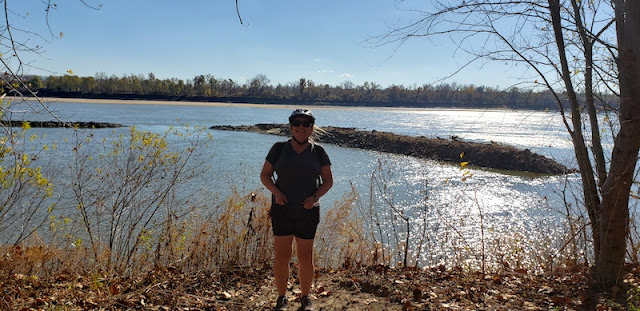 |
We had a comfortably warm and sunny day biking the Katy Trail in St. Charles, Missouri. |
We have visited friends we’ve had since childhood, former coworkers, and people we otherwise probably wouldn’t see again outside of a random drive-by visit for a walk in the park or a cup of coffee, wine, or a gin and tonic.
 |
The Katy Trail is popular with bicyclists, walkers, and runners. |
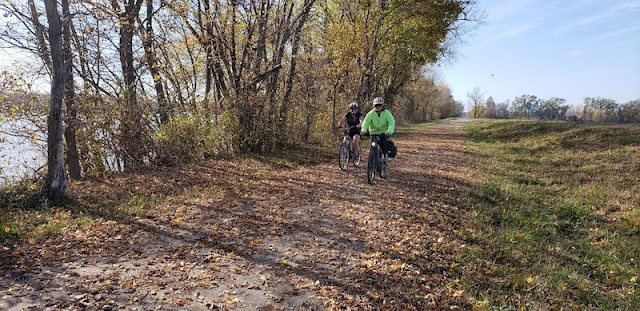 |
We rode at an easy pace, so we could chat and catch up along the way. |
Some of these visits have turned out to be poignant. Sadly, we lost a few friends and relatives shortly after our visit.
Other visits have been a way to reconnect with people who were once important in our lives but drifted away after they moved or retired.
When you meet someone, you don’t know if that person will become a friend or for how long. You also don’t know if you will ever see that person again when you say goodbye. We never regret taking the time to visit friends when we have the opportunity.
During the 90s and 2000s, K&K worked with Roger as Alaska Department of Fish and Game fish techs on trout research projects. These projects estimated the abundance of cutthroat trout in remote lakes in Southeast Alaska or counted fish migrating through a weir. Over the years, Roger developed strong friendships with K&K, lasting through retirement and across many miles.
K&K are active bicyclists, so when we added the Katy Trail, a prime biking destination, to our itinerary, we called to see if they would join us. The trail was a reasonable driving distance from their new home in Minneapolis, and we were overjoyed when they said yes.
On our first day of biking, we were excited to see K&K again for the first time in a few years. We met them just outside Sundermeier RV Park's back gate in a Katy Trail designated parking lot. After joyful hellos and hugs, we started for Frenchtown, the first capital of Missouri, today an art district in historic St. Charles and just one mile down the trail. Located along The Katy Trail, Frenchtown welcomes bicyclists looking for a meal, a cold drink, or a resting place. The cobblestone and brick streets were easy to manage. |
The trail to Walnut Depot bordered farm fields. |
We rode to La Belle Vie, an elegant yet cozy cafe on North 2nd Street. Roger ordered The Lake Bake, a stack of crispy hash brown patty, chopped bacon and sausage, an over-easy egg, and sausage gravy. K1 ordered the brown butter crepes, and K2 and I each got the veggie omelet. We enjoyed a relaxed meal catching up.
With bellies full, we continued riding as far as River Bottom Trailhead, then returned to the RV Park. |
After a day of biking the Katy Trail, we enjoyed a happy hour beverage at Sundermeier RV Park. |
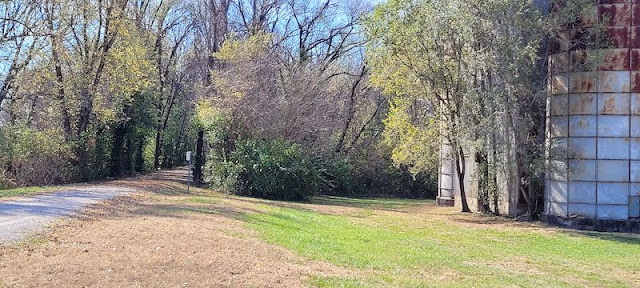 |
Black Walnut Trailhead was the end of the line for us on our second day of biking the Katy Trail. |
 |
The Katy Trail in Missouri is a destination for RVers who like to bicycle. |
 |
This snapshot of the trail map (in green) shows the section of trail we road. |
We returned to the RV park just as darkness settled in and, sadly, said our goodbyes to K&K with the possibility of visiting again this summer in Southeast Alaska.
“You meet people who forget you. You forget people you meet. But sometimes you meet those people you can’t forget. Those are your friends”
― Mark Twain
Recap: My husband and I drove our Pleasure Way RV van, Sweet Van-Ella Magnolia, from the East to West Coast. On October 22, 2022, we left Midlothian, Virginia, where Ella had been in storage. We drove through West Virginia to Kentucky. Our destination was Palm Springs, California.
This Halloween, we were unexpectedly haunted—not by the tricks and treats of playful goblins and witches, but by the troubling truth of destructive development and the ugly parts of United States history.
Mammoth Cave National Park—October 31, 2022
Mammoth Cave National Park was missing from our original itinerary, but we adjusted our schedule when we saw we were going right by it. Never a good idea to drive past a National Park without stopping.
 |
We enjoy traveling in our Pleasure-Way RV van during the shoulder season. Little did we know, this would be our last trip in our Sweet Van-Ella. More on that in a future article. |
We arrived shortly before the visitor center closed and purchased tickets for a Mammoth Cave tour the following day. The park offers many types of tours, including a fully wheelchair-accessible tour and a limited number of self-guided tours. We lucked out because many of them were sold out, and we found space for an early one that would allow us to get on the road the following afternoon.
The campground was sparsely occupied and quiet. Our only visitors were a doe and her fawn—not skittish at all, foraging the perimeter of our campsite. (I took a video of the deer instead of a photo. I’ll upload a clip here when I have it ready.)
We built a fire and used the wifi to check in with friends and family. When my son heard where we were, he sent a link to a video he had recently watched—the animated Internet Historian movie “Man in Cave” about the 1925 two-week attempt to rescue Floyd Collins, who had been trapped in a cave. Was it a coincidence or spooky serendipity that Joe had recently seen the movie, and we just happened to visit Mammoth Cave?
“Man in Cave” had been released on Youtube just one month earlier and already had 7.8 million views. The video is currently being re-edited. I will add a link after it has been re-uploaded to Youtube.
 |
Ranger Josh prepared the tour group for its trip underground. |
 |
We explored the cave via lighted, paved walkways. |
The same limestone that makes the best Kentucky bourbon is what made Mammoth Cave the world’s largest known cave. Or, I should say, the lack of limestone made the cave when 10-15 million years ago, water running across the earth’s surface seeped through cracks deep into the ground and eroded the softer limestone away from the rigid rock walls of more than 400 miles of explored cave passages.
 |
After the tour, we pulled into one of the picnic areas. We made sandwiches while watching the squirrels scamper through the crunchy fallen leaves. |
Paradise, Kentucky
Our next stop was a real Halloween adventure. We went to a ghost town with a history scarier than any Stephen King novel. If you’re a John Prine fan, “Y’all know the story behind it.”
Roger’s sister is into genealogy. When she heard we would be driving through Kentucky, she suggested we visit some kinfolk graves.
Roger’s fifth-great grandparents, Leonard and Martha Stom, are buried in the McDougal Cemetery in what was once Paradise, Kentucky. In the 1800s, they ran the ferry across the Green River at Stom’s Landing. Sounds idyllic, doesn’t it? At the time, Muhlenberg County was a lush, green countryside full of birds and wildlife with fish thriving in the Green River. [1]
John Prine’s song “Paradise,” tells the story of what happened next. “Mr. Peabody’s coal train has hauled it way.”
We Googled Paradise and the McDougal Cemetery to get directions. Findagrave.com sent us down Route 176 to where Paradise used to be. But we were too late. All we found was scorched earth and a mammoth coal-fired power plant that appeared to be closed.
 |
A defunct coal-fired power plant is all that is left of Paradise, Kentucky. |
The Kentucky Genealogical Society describes coal mining development in Eastern Kentucky on its website.
“Along with tobacco, racehorses, and bourbon, coal has long been part of the defining narrative of Kentucky’s history. Serious coal mining in Kentucky had its modest beginning in 1820 with the opening of a commercial mine in Muhlenberg County, but it wasn’t until the late nineteenth century that coal became a significant factor in the economy of the Commonwealth. By the time of the first world war, railroads had connected mountain coal and timber operations with urban industrial centers, and the die was cast.” [2]
Strip mining in Kentucky began in 1826 near Sugar Creek. Strip mining removes a long strip of land to access coal relatively close to the surface. “A coal company that owned the rights under your land could come in with explosives and huge shovels to remove the rock and soil, haul the coal away, and pretty much leave the area looking like the surface of the moon. And the landowner had little recourse” thanks to Kentucky’s “treacherous legal instrument in effect known as the broad form deed, which gave primacy to the mineral owner over the surface owner.” [3]
 |
Our route from Louisville to Mammoth Cave, Paradise, and John James Audubon Park. Paradise is at the marker just east of Central City. |
In the 1900s, the Peabody Energy Company, based in St. Louis, Missouri, strip-mined the land surrounding the town of Paradise. In 1959, the Tennesee Valley Authority (TVA) began constructing the Paradise Fossil Plant. The plant burned 20,000 tons of coal every day. [4]
This coal-fired power plant rained toxic ash on the surrounding land, poisoning the river and creating a health hazard for residents. In 1967, the TVA convinced the remaining residents to move out and built the world’s largest cyclonic-fired boiler. [5]
A 2010 Abt Associates study attributed 93 deaths per year to fine particle pollution from the Paradise Fossil Plant. [4]
In 2019, the TVA board voted to close the coal-fired power plant by December 2020 because it was no longer cost-effective. [6]
Research tells us that doing nothing can sometimes be more economically beneficial than tearing up the earth and destroying waterways for short-term commercial gain. The waste created and human lives lost in exchange for a fossil fuel plant that lasted just 120 years boggles my mind. Imagine what Paradise might look like today had it been left alone.
In response to environmental disasters like Paradise, the United States established laws and agencies to protect us from the dramatic degradation committed by past resource extraction and development. Today, when considering applications for resource extraction and development permits, agencies compare the intrinsic value of the land—the value the land has in its pristine state—to the financial gain of the resource being extracted (lumber, gold, oil, coal, or other minerals.) In Alaska, for example, a historically productive watershed left intact will contribute millions of dollars to the local economy every year for centuries via the salmon it will produce.
In simpler terms, if we leave the river alone and do nothing, it will provide a living to many people for a long time.
Back to our story—the cemetery was supposed to be on top of a hill near the plant, but we never found it. This place gave me the cold creeps, and we wanted to get to our next destination before dark. We drove around the area, ignoring the WARNING-KEEP OUT signs. I felt like we were in an episode of Scooby Doo, driving our van to a deserted old factory to solve a mystery. Eventually, we decided to scram.
John James Audubon Center and Campground
We were disappointed we didn’t find McDougal Cemetery but had to keep moving. We checked into our campsite at the John James Audubon State Park and took advantage of the shower facilities and fire ring. Again, we were in the shoulder season, and the campground was quiet, just right for our unlux travel style.
 |
The sun rose from behind the dam at our campground in Henderson, Kentucky. |
In the twilight of the morning, I peeked out our rear window to see deer grazing on green grass in the foggy morning light. A sign. It’s going to be a good day. I had recently taken an interest in birding, and we were to visit the Audubon Museum and Nature Center. Supported by Friends of Audubon, the museum houses one of the largest collections of original Audubon paintings, prints, and artifacts.
To be honest, I didn’t know much about John James Audubon. I had heard about the National Audubon Society, but that’s about it. Juneau has an active Audubon Society. (You’d better arrive early to purchase their nagoon berry jam at the annual Public Market.)
John James Audubon was the best-known wildlife artist of his time. However, The National Audubon Society says he is also “a complex and troubling character who did despicable things even by the standards of his day. He was contemporaneously and posthumously accused of—and most certainly committed—both academic fraud and plagiarism. But far worse, he enslaved Black people and wrote critically about emancipation. He stole human remains and sent the skulls to a colleague who used them to assert that whites were superior to non-whites.” [7]
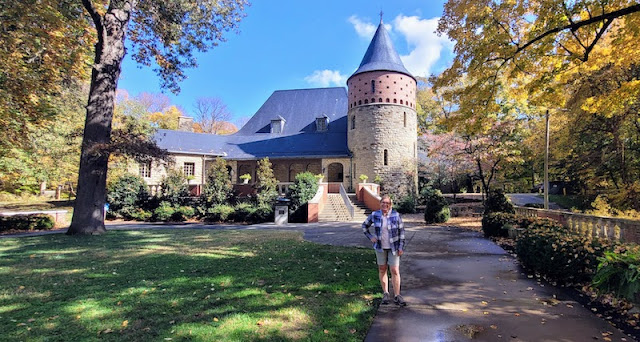 |
The Audubon Park and Museum are an oasis from the busy highway just outside its border. |
Ironically, evidence suggests that John James Audubon, born in Haiti, was the son of his father and a mixed-race housekeeper. He was also a privileged fellow who went to France at the start of the Haitian Revolution and, years later, to the United States to avoid conscription in Napolean’s military.
Audubon worked as an unsuccessful businessman who bought and sold enslaved people. He operated a store in Henderson, Kentucky, where his family lived from 1810 until he was jailed for bankruptcy in 1819. Eventually, he published The Birds of America, 453 life-size paintings of North American birds. Audubon’s realistic paintings portrayed birds in natural poses and often included flora of the bird’s habitat. [8]
The National Audubon Society considered changing its name in light of Audubon’s racist views; however, its board of directors decided against it and announced the rationale behind the decision in a press release dated March 16, 2023. [9]
Three board members resigned in protest. [10]
 |
We enjoyed the vibrancy of autumn colors as we traveled from East to West in our RV van. |
I was taken aback by Audubon’s racist past. I only learned of it when I began additional research for this article more than five months after my visit. Neither Roger nor I recall this information as part of the exhibit at the museum. I can’t say it wasn’t there, but I can’t imagine I would miss or forget something as important as that.
Notes:
[1] Jenn Shockley, “A Creepy Ghost Town In Kentucky, Paradise Is The Stuff Nightmares Are Made Of,” Only in Your State, June 7, 2020. https://www.onlyinyourstate.com/kentucky/ghost-town-ky/
[2] Marsha Waggoner, “Loading Sixteen Tons: Tracing Your Kentucky Coal Mining Ancestors,” Kentucky Genealogy Society, accessed April 7, 2023, https://kygs.org/genealogy-tips/eastern-ky-coal-mining-records.html
[3] Frank Boyett, “Fifty Years Ago, Strip Mining Talk Rippled Through Henderson County,” Henderson Gleaner, USA Today Network, May 6, 2017, https://www.thegleaner.com/story/news/columnists/frank-boyett/2017/05/06/fifty-years-ago-strip-mining-talk-rippled-through-henderson-county/101255312/
[4] “Death and Disease Attributable to Fine Particle Pollution from the Paradise Fossil Plant” Paradise Fossil Plant, Global Energy Monitor Wiki, accessed April 7, 2023, https://www.gem.wiki/Paradise_Fossil_Plant#Background
[5] “Paradise, Kentucky,” Wikipedia, accessed April 1, 2023, https://en.wikipedia.org/wiki/Paradise,_Kentucky
[6] “Paradise Fossil Plant,” Tennessee Valley Authority, accessed April 18, 2023, https://www.tva.com/energy/our-power-system/coal/paradise-fossil-plant
[7] “John James Audubon A Complicated History,” National Audubon Society, accessed April 10, 2023, https://www.audubon.org/content/john-james-audubon
[8] Bill Chappell, “Audubon Faces a Backlash After Deciding to Keep Name That Evokes a Racist Enslaver,” National Public Radio, April 10, 2023, https://www.npr.org/2023/03/18/1164293652/audubon-faces-a-backlash-after-deciding-to-keep-name-that-evokes-a-racist-enslav#:~:text=The%20first%20to%20ditch%20the,it’ s%20now%20called%20Nature%20Forward
[9] “National Audubon Society Announces Decision to Retain Current Name, “National Audubon Society, March 16, 2023, https://www.audubon.org/news/national-audubon-society-announces-decision-retain-current-name
[10] Robin Bravender, “Backlash hits Audubon after Refusal to Drop Slave-holder’s Name,” Politico, March 16, 2023, https://www.politico.com/news/2023/03/16/audubon-board-members-resign-00087423
© Copyright 2023. Patricia E. Harding. All rights reserved.Recap: My husband and I drove our Pleasure Way RV van, Sweet Van-Ella Magnolia, from the East Coast to the West Coast. On October 22, 2022, we left Midlothian, Virginia, where Ella had been in storage. We drove through West Virginia on our way to the Bourbon Trail. Our destination was Palm Springs, California.
In Pursuit of Bourbonism — October 26 & 27, 2022
We left West Virginia and entered the forested hills and valleys of the Eastern Kentucky Coal Field. Layers upon layers of sediment collected here for 250 million years when seawater covered the land. Each new layer compressed previous layers, and the pressure turned seashells into limestone and peat swamps into coal.
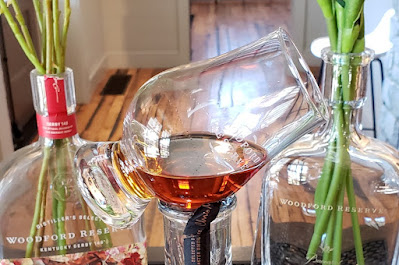 |
The tasting at Woodford Reserve included a souvenir glass. |
Limestone makes the best water for the best bourbon, and coal has powered the electricity and much of the economy of Kentucky for two centuries.
We drove west on I-64 to the Outpost RV Park in Salt Lick and stopped for the night. The Outpost was a wide-open, spacious park run by warm country folk. When I called to make a reservation several weeks earlier, the man on the phone, whose voice sounded elderly, only took our name. I imagined him penciling us into a big, bound reservation book.
“That’s it?” I asked.
“That’s it,” he said.
I was used to filling out online forms and providing a long list of information—vehicle length, number of people, pet information, hookups needed—as well as a deposit and credit card information.
 |
Much of western Virginia, West Virginia, and eastern Kentucky was covered in soft-peaked mountains and pastureland where black Angus cattle grazed. |
We saw lots of licks around these parts. And hollows, traces, and gaps. A lick is where a spring with salt reaches the surface. The salted spring attracts animals that lick the salt and mineral deposits left by the spring. Historically, animals created paths or traces through the woods and mountains that Native American hunters, traders, and later pioneers used before modern roads were built.
A hollow (pronounced holler in these parts) is a small valley. A trace is a beaten path or minor road, a track. A gap is a low area between two higher-elevation land masses. A gap is more rugged than a pass. A notch is more rugged than a gap.
Traveling on these roads through the mountains reminded me of the illustrated children’s book, Who Came Down That Road? by George Ella Lyon and illustrated by Peter Catalanotto. A young boy walks with his mother through the woods and asks, “Who came down that road, Mama?” The mother answers him, and the boy repeatedly asks, “Who came before that?”
We found Allegheny Mountain Radio, the listener-supported community radio station in Dunmore, West Virginia.
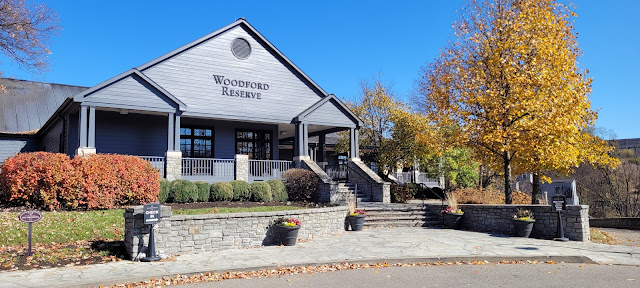 |
| Woodford Reserve offers several tastings and tours at its Versailles, Kentucky, distillery. |
We started our Bourbon Trail adventure at Woodford Reserve in Versailles, Kentucky. (Pronounced Ver-SAL-Less.) Roger did the Signature Tasting while I enjoyed sitting and reading in the sun on Woodford’s beautiful campus. After Roger’s tasting, we went to the Cocktail Bar, where Roger sampled another pour. (I had a few tiny sips to taste, but I prefer wine.)
Absentee Voting in the Midterm Election
It was important to both of us to do everything possible to vote in the critical mid-term elections, so before arriving in Louisville, we visited the Woodford County Library in Versailles, where we printed our electronic delivery ballot from the Alaska Division of Elections. The email they sent after we requested online delivery (back in Marlinton, WV) included a link and a code to access our ballots.
We filled out the ballot online, then downloaded and printed them at the library. We opted to fax rather than snail mail them back to Alaska. By faxing, we gave up privacy, but we didn’t want to risk our ballots being delayed by the U.S. Postal Service. If we had wanted to return the ballots by mail, the ballot package included a template for an envelope we could have cut out, folded, and taped.
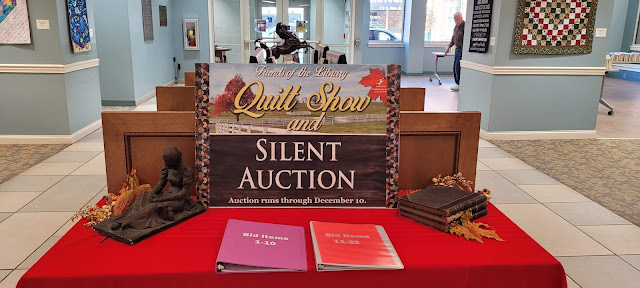 |
| Quilts and artwork on display throughout the Woodford County Library were part of a silent auction fundraiser. |
 |
| The view from our back-in site at Louisville North Campground. |
The park was surprisingly quiet, with just the low rumbling of a train going by now and then on a railbed just above our site. The other guests were a combination of retired people like us enjoying the on-the-road lifestyle. We also observed workers who lived in the park and left early each morning for their jobs as contractors and laborers. It looked as if one young family lived there full-time. Children played with toys lying about their campsite and road through the park on an oversized tricycle.
Bourbon and Baseball — October 28, 2022
We took an Uber to Main Street, downtown Louisville, and the Louisville Slugger Museum. The tour walked us through the production area and included extensive baseball history and memorabilia exhibits. The Bat Vault contained more than 3,000 bat models or templates from celebrity players such as Babe Ruth and Ted Williams, who designed their own bats. The company has been making baseball bats since 1884 and displays an essential part of American history and its favorite pastime. Today, bats are made mainly by computerized machines. The factory workers operated and fed the machines, added details, and completed other tasks machines couldn’t do.
 |
The tour guide demonstrated how bats were once turned by hand on a lathe. |
We continued down Main Street for more bourbon tasting at Michter’s Fort Nelson Distillery, Evan Williams, and Old Forester downtown. We ate lunch at Jockey Silks Bourbon Bar and later had a drink at Merle’s Whiskey Kitchen.
 |
We tasted a flight at the Old Forester bar. |
Jockey Silks, located inside the Galt House Hotel, had great reviews. I enjoyed the upscale whiskey bar decor—fancy compared to our unlux travel style.
We walked to Angel’s Envy, where Roger had a distillery tour reservation at 6 pm. The bar was open only to tour guests, and tours usually fill up weeks in advance. A guide told me same-day visitors are often disappointed when they arrive and can’t taste or tour. When we made a reservation a few days in advance, a 6 pm spot was one of only two left that day.
 |
Inside the Angel’s Envy Distillery in downtown Louisville, Kentucky. |
Since I’m not a whiskey, I mean bourbon, drinker, I waited in the reception area while Roger toured the distillery. While I waited, three different staff people invited me to the bar to meet Roger at the end of his tour. I kept declining because I was perfectly content sitting quietly, people-watching, and reading. When the third person insisted, “Your husband asked me to get you,” I went up the elevator to the beautiful bar. Roger was like a kid in a candy store and showed me around as if he worked there.
Angel’s Envy was Roger’s favorite bourbon experience, and the rye with the Caribbean Cask finish is his favorite bourbon. We didn’t purchase a bottle there because we knew we could buy it in Juneau for about the same price. (We needed to travel light for our eventual plane ride home.) However, Roger did buy a bottle of Old Forester to enjoy during the rest of our RV van travel to Palm Springs.
 |
Our route from New River Gorge National Park to Louisville, Kentucky. |
We returned to Merle’s to eat dinner after the Angel’s Envy experience. Merle’s is known for its fried chicken and tacos. It was hopping when we got there. A live band played, and customers waited out the door. The weather was comfortable enough to sit outside. We ate the fried chicken and caught an Uber back to the campground.
Mint Juleps at Churchill Downs — October 29, 2022
We drove Van-Ella to Churchill Downs and the Kentucky Derby Museum the following day for a scheduled tour. A football game was starting at the University of Louisville stadium just down the road, and traffic was thick, with many fans walking to the stadium.
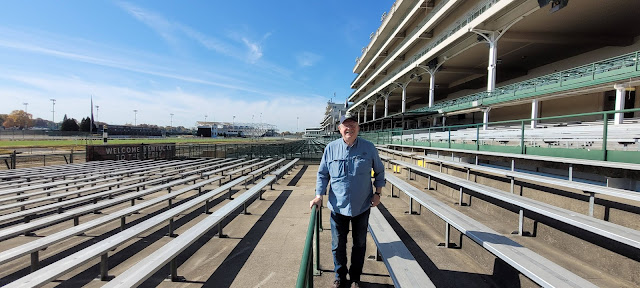 |
| The Churchill Downs tour includes a visit to the track. |
We’re not big horseracing fans, but since we’re here, we thought we should visit the home of the Kentucky Derby. The tour took us to the racetrack, and our guide told stories about the derby’s history and current operations. One of my takeaways from visiting the museum was the critical role Black people played in the early days of horse racing and their contributions as jockeys, groomsmen, and trainers.
The Black Heritage in Racing exhibit highlighted contributions to horseracing from Black Americans, including Oliver Lewis, Jimmy Winkfield, and Isaac Murphy.
One of the oil paintings reminded Roger of a book he recently read, Horse by Geraldine Brooks.
The exhibit reminded me of a recent conversation with a woman I met in Virginia who missed “the little Black jockey” once displayed at a restaurant. She didn’t understand why it had been removed. Out of curiosity, I Googled the history of the Black jockey lawn ornaments.
An urban legend tells the tale of a young Black boy who froze to death, helping General George Washington cross the Delaware River during the Revolutionary War. Legend says that Washington commissioned a statue depicting a Black jockey with a lantern, “The Faithful Groomsman,” for his Mount Vernon home. The figure is said to symbolize duty and obedience.
Another story circulated in the 1970s and said the Black jockey lawn ornaments guided enslaved people fleeing the South via the Underground Railroad.
 |
| “The Bath” by Lily Swan, Grade 11, Mercy Academy. 2022 Grand Prize Winner in the Kentucky Derby’s Horsing Around with Art contest. The artist said, “I wanted to capture the caring relationship between the thoroughbred and those who tend to this beautiful horse.” |
 |
We enjoyed a traditional mint julep at The Derby Café. |
We ended our visit with lunch at the cafe and enjoyed a traditional Churchill Downs mint julep in the souvenir 2022 glass. I ordered the hot brown, a traditional Kentucky panini-style sandwich with turkey, bacon, and mornay sauce. Roger had the grilled bbq brisket.
Limestone Water Makes the Best Bourbon — October 30, 2022
One could spend several days or a week or more visiting the bourbon distilleries on Kentucky’s Bourbon Trail, officially established in 1999 by the Kentucky Distillers’ Association. We didn’t have that much time and chose Maker’s Mark in Loretto for our final bourbon stop.
If you go, call ahead and get the driving directions. Google will mislead you. Trust us!
Maker’s Mark is one of the most popular bourbons. I like Maker’s Mark because it is a B Corporation. B Corporations hold special certification that eases profit-making requirements to allow for benefits to the planet, people, and community. Maker’s Mark’s zero-landfill, white oak sustainability, and community service initiatives qualify them for B Corporation status. As a consumer, I look for B Corporations when shopping.
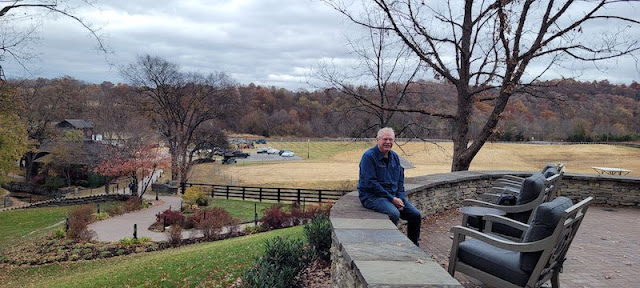 |
Maker’s Mark is a beautiful destination, even for non-bourbon drinkers. |
I also appreciated Mrs. Samuels's role in the business's development. While Bill Samuels, Jr., was reinventing the family’s six-generation-old bourbon recipe in 1953, his wife, Margie Samuels, was designing the most recognizable bourbon bottle anywhere. Today, visitors can hand-dip their own bottles in the hot red wax and create one-of-a-kind souvenirs.
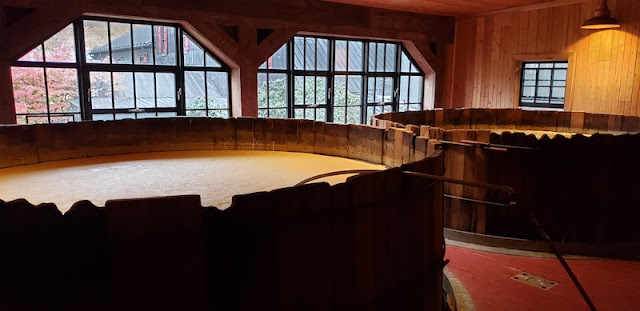 |
Maker’s Mark still uses the old wooden fermentation vats. |
Again, Roger left on a tour of the pastoral and immaculate distillery, once known as Star Hill Farm. I settled in the bar, wrote, and people-watched. Eventually, I couldn’t stand it any longer and wandered down the hill across Whiskey Creek to the gift shop, where I purchased various bourbon balls.
 |
Makers Mark celebrates co-founder Margie Samuels with a stained-glass enclosed vestibule housing her pewter collection and honoring her contributions to the family’s bourbon business. |
Roger reported that while he liked some of the more “high-end” bourbons he sampled, he was impressed with some of the more affordable bourbons from (to him) the lesser-known distilleries. He was impressed with the rye bourbons at Evan Williams and Old Forester and, of course, the “classically smooth” Maker’s Mark bourbon. His favorite is still the Angel’s Envy Carribean Cask finish.
We skipped drinking at Maker’s Mark—except for Roger’s tasting and tour—because we had a drive ahead of us to our campsite for the night, Mammoth Caves National Park, a place we almost missed. The next day was Halloween. What better way to spend it than wandering through the dark and creepy hollows of the earth?
 |
Maker’s Mark displayed images from old marketing campaigns. |
*******
Birds picked up in Louisville by Merlin Sound IDCarolina wren, Blue jay, Northern cardinal
*******
“To truly love we must learn to mix various ingredients—care, affection, recognition, respect, commitment, and trust, as well as honest and open communication.”
― bell hooks, All About Love: New Visions
*******
© copyright 2022. Patricia E. Harding. All rights reserved.